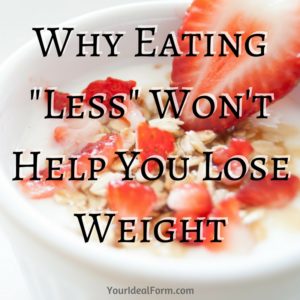
A big portion of weight loss advice gets boiled down to: “Eat less, move more.” Let’s tackle that first part: just eat “less”. That’s not very specific though, is it? How much less are you supposed to eat? And less than WHAT exactly? Less than before? Less than a breadbasket?
People generally go wrong with eating “less” in one of two ways. In one camp, we have those who cut way, way, WAY back, and start eating very little. Inevitably this leads to them being hungry all the time, and eventually they give in to their hunger and eat the entire kitchen. Then they feel awful about it, and give up, thinking they’ll never be able to lose weight.
On the flip side are those who know they should take things gradually, so they cut back a little based on their previous eating habits. Often, however, they aren’t relying on hard data. It could well be that previously, their eating regimen had them gaining weight at a slow creep of five pounds a year. Now they’ve cut back a tiny bit, so they’re only gaining at two pounds a year. While this is a step in the right direction, when they step on the scale and don’t see a change, they get frustrated, decide that eating less is of no use since the numbers aren’t going down anyway, and give up, thinking they’ll never be able to lose weight.
While eating “less” is generally accepted as true, one important piece that is missing is just how much less to eat. Eating the right amount will keep you on a steady pace to reach your goals. It is also important to eat enough, so you aren’t left “starving” and frustrated and wanting to quit.
So, exactly how much “less” should you eat so that you hit the sweet spot of not eating like a bird while still seeing results? For that, we’ll need to do some math. We need to determine, based on your current height and weight, how many calories your body burns just keeping you alive. Pumping blood, digesting food, breathing… all that stuff our brain handles for us without us having to think about it. Then we’ll multiply that by a factor of how active you are. That is how many calories total your body burns each day or your Total Daily Energy Expenditure (TDEE). I won’t make you actually do all the math; you can use any number of online TDEE calculators to come up with your number. Take in fewer calories, and your body makes up the difference by burning some excess fat. Take in more, and your body stores the extra as fat. The generally accepted equation is that one pound of fat is around 3500 calories. So to lose one pound a week, we can divide that by seven, and you come up with needing to eat 500 calories below your TDEE each day to hit that one pound a week goal. If you are currently eating well above your TDEE, cut back slowly. Don’t make the mistake in the example above of cutting back too quickly without getting used to it!
Keep in mind that despite all the SCIENCE! and MATH! that goes into this, your TDEE calculation is still an estimate. If you are not seeing results after a few weeks, and you are certain you are tracking your intake correctly, you may need to adjust how many calories you are taking in.
Have you tried eating some arbitrary amount of “less” before? How did it work out for you? Let me know in the comments!

